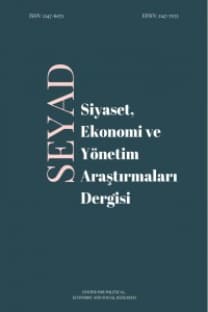Ekonomik Büyüme, Ar-Ge Harcamaları, İhracat ve Net Yabancı Sermeye Girişinin Ülkelerin Ekonomik Fitnes Endeksi üzerindeki Etkisi
Ekonomik Fitnes, Ekonomik Göstergeler, Panel Eşbütünleşme, Panel Nedensellik
Effects of Economic Growth, R&D Expenditures, Exports and Net Foreign Capital on Economic Fitness Index of Countries
___
- Breitung, J. ve Pesaran, M. H. (2008), Unit Roots and Cointegration in Panels. in The Econometrics of Panel Data, Springer, Heidelberg. Berlin, Germany.
- Cristelli, M., Gabrielli, A., Tacchella, A., Caldarelli, G. ve Pietronero, L. (2013), “Measuring the Intangibles: A Metrics for The Economic Complexity of Countries and Products”, PloS One, Volume:8, Issue:8, p.1-20.
- Emirmahmutoglu, F. ve Kose, N. (2011), “Testing for Granger Causality in Heterogeneous Mixed Panels”, Economic Modelling, Volume:28, Issue:3, p.870-876.
- Gülmez, A., ve Yardımcıoğlu, F. (2012), “OECD Ülkelerinde Ar-Ge Harcamaları ve Ekonomik Büyüme İlişkisi: Panel Eşbütünleşme ve Panel Nedensellik Analizi (1990-2010)”, Maliye Dergisi, Cilt:163, Sayı:1, s.335-353.
- Im, K.S, Pesaran, M.H. ve Shin, Y. (2003), “Testing for Unit Roots in Heterogeneous Panels”, Journal of Econometrics, Volume:115, p.53–74.
- Levin, A., Lin, C. ve Chu, C.J. (2002), “Unit Root Tests in Panel Data: Asymptotic and Finitesample Properties”, Journal of Econometrics, Volume:108, p.1–24.
- Narayan, P. K. ve Wong, P. (2009), “A Panel Data Analysis of The Determinants of Oil Consumption: The Case of Australia”, Applied Energy, Volume:86, Issue:12, p.2771- 2775.
- Nelson, C. R. ve Plosser, C. R. (1982), “Trends and Random Walks in Macroeconmic Time Series: Some Evidence and Implications”, Journal Of Monetary Economics, Volume:10, Issue:2, p.139-162.
- Pedroni, P. (1999), “Critical Values for Cointegration Tests in Heterogeneous Panels with Multiple Regressors”, Oxford Bulletin of Economics and Statistics, Volume:61, Issue:S1, p.653-670.
- Pedroni, P. (2001), Fully Modified OLS for Heterogeneous Cointegrated Panels. In Nonstationary Panels, Panel Cointegration, and Dynamic Panels, Emerald Group Publishing Ltd., Bingley, UK.
- Phillips, P. C. ve Hansen, B. E. (1990), “Statistical Inference in Instrumental Variables Regression with I (1) Processes”, The Review of Economic Studies, Volume:57, Issue:1, p.99-125.
- Romer, P. M. (1989), “Human Capital and Growth: Theory and Evidence” National Bureau of Economic Research, No. w3173, p.1-49.
- Roster, K., Harrington, L. ve Cader, M. (2018), “Country Case Studies in Economic Fitness: Mexico and Brazil”, Entropy, Volume:20, Issue:753, p.1-16.
- Saikkonen, P. (1991), “Asymptotically Efficient Estimation of Cointegration Regressions”, Econometric Theory, Volume:7, Issue:1, p.1-21.
- Sbardella, A., Pugliese, E., Zaccaria, A. ve Scaramozzino, P. (2018), “The Role of Complex Analysis in Modeling Economic Growth”, arXiv preprint arXiv, No:1808.10428, p.1- 19.
- Servedio, V., Buttà, P., Mazzilli, D., Tacchella, A. ve Pietronero, L. (2018), “A New and Stable Estimation Method of Country Economic Fitness and Product Complexity”, Entropy, Volume:20, Issue:783, p.1-15.
- Stock, J. H. ve Watson, M. W. (1993), “A Simple Estimator of Cointegrating Vectors in Higher Order Integrated Systems”, Econometrica: Volume:61, Issue:4, p.783-820.
- Tacchella, A., Mazzilli, D. ve Pietronero, L. (2018), “A Dynamical Systems Approach to Gross Domestic Product Forecasting”, Nature Physics, Volume:14, p.861–865.
- The World Bank, (2018), World Development Indicators, http://databank.worldbank.org 12.09.2018.
- Vinci, G. ve Benzi, R. (2018), “Economic Complexity: Correlations between Gross Domestic Product and Fitness”, Entropy, Volume:20, Issue:766, p.1-8.
- Westerlund, J. (2007), “Testing for Error Correction in Panel Data”, Oxford Bulletin of Economics and Statistics, Volume:69, Issue:6, p.709-748.
- ISSN: 2147-6071
- Yayın Aralığı: Yılda 2 Sayı
- Başlangıç: 2014
- Yayıncı: Politik Ekonomik ve Sosyal Araştırmalar Merkezi
Mehmet YILMAZ, Ertuğrul Sinan KIZMAZ, İsmail GÖKTÜRK
G-7 ve G-20 Ülkelerinde İyi Yönetişim Nasıl Olmalı?: Teorik Bir Değerlendirme
Mine IŞIK, Özlem Öztürk ÇETENAK
Ömer İSKENDEROĞLU, Saffet AKDAĞ
Örgütsel Güven ile Bireysel İş Performansı Arasındaki İlişki
Mithat TURHAN, Onur KÖPRÜLÜ, İlter HELVACI
Kalkınma Ajansları Yoluyla Yapılan Yatırım Teşviklerinin 2013-2014 Döneminde Etkinlik Analizi
Ümran ŞENGÜL, Ahmet Bilal ŞENGÜL
İşletmelerde Kalitesizliğin, Verimsizliğin ve Markalaşamamanın Maliyet Üzerine Etkisi
Mehmet ÇOLAK, Tahsin ÇETİN, Abdi ATILGAN
Siyasal İletişimde Propaganda Aracı Olarak Seçim Müzikleri: 24 Haziran 2018 Seçimleri Örneği
2000’lerde Türkiye Ekonomisi Performansı
Managerial Roles for Health Services: Quinn’s Competing Values Framework CVF Model
Gamze Bayın DONAR, İlkay Sevinç TURAÇ
Mobilya Sektöründeki Personellerin Mühendisten Beklentileri Örnek Bir Uygulama
